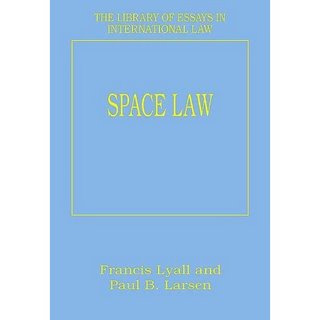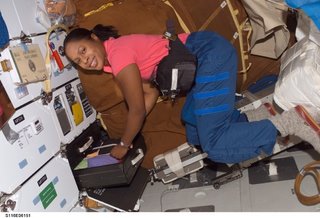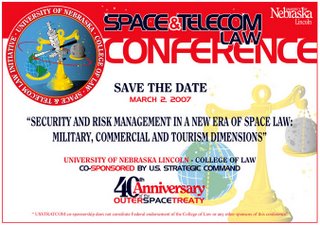12.29.2006
Cheers!
 Happy New Year and safe landings from Space Law Probe!
Happy New Year and safe landings from Space Law Probe!See you in 2007... ;)
* * *
Image credit: Astronomical (and other) artist Mark A. Garlick's digital depiction of the Milky Way Galaxy.
12.26.2006
Inked space
 Ah, the digital age. So many pixels, so little time to eyeball books.
Ah, the digital age. So many pixels, so little time to eyeball books.Well, if your idea of a rousing New Year's celebration is to cuddle up at home and indulge in an orgy of space law book reading, here are just a few notable new titles for your indulgence.
But never mind all that geeky law stuff. It's a party. Skip right to the hottest space title from the summer of 2006. . .
By the way, if you are tired of space law and want to try something altogether new or perhaps more down to earth in 2007 -- and don't worry about me, I'm a big girl, I won't be offended -- here is a sizzling new Introduction to Air Law by I. H. Philepina Diederiks-Verschoor and M. A. Butler.
Oh sure. You'll be back.
Enjoy!
12.20.2006
America's Rules for Riding Rockets
 For the past few years each December, an important new space law development -- legislation, proposed rulemaking, final rule -- has turned up in our holiday stockings.
For the past few years each December, an important new space law development -- legislation, proposed rulemaking, final rule -- has turned up in our holiday stockings.In case you missed it last Friday, a bit short of the two-year anniversary of President Bush signing into law the Commercial Space Launch Amendments Act of 2004 (CSLAA) (Dec. 23, 2004), and almost a year after the commercial space transportation regulators first circulated proposed human space flight requirements (NPRM, Dec. 29, 2005), FAA has published the final rule, Human Space Flight Requirements for Crew and Space Flight Participants (14 CFR Parts 401, 415, 431, 435, 440 and 460).
Ring in the new. As we know, Congress gave FAA/AST no authority to protect space flight passenger safety until 2012. Pursuant to the CSLAA, in this final rule the regulators mandate informed consent for space flight participants and crew, and set forth requirements for qualifications and training of crew. The rule ensures "an acceptable level of safety" for the uninvolved public and that "individuals on board are aware of the risks associated with a launch or reentry." The rule finalizes issues involving waiver of liability and financial responsibility. Ready to fly? You must consent to go at your own risk and promise not to sue the US government. Climb aboard.
(Unspoken rules: 1. FAA does not say "space tourist." At least while rulemaking. 2. As far as the federal government is concerned, space flight participant is three words. However, spaceflight industry can be two.)
In carefully promulgating these requirements for the newborn human space flight industry, as is the agency's style in exercising its space transportation regulatory authority, FAA/AST paid close attention to the thoughtful and varied public comments it received. (Our attentive regulatory agency tallied up comments submitted in response to the NPRM and noted for the federal record that, "forty-two entities, including aerospace companies, associations, service providers, individuals and other agencies of the U.S. Government" commented, including operators of launch and reentry vehicles which FAA listed separately: Blue Origin, Rocketplane, TGV Rockets, XCOR, as well as the Personal Spaceflight Federation - which includes pretty much every rocket company that stands to be impacted by these rules any time soon.)
As FAA modestly noted, "In general, the commenters supported the proposed requirements, [yes, here in blogspace we could not help noting the love fest ourselves--JL] but with several suggested changes." And in its for-the-record discussion of the final rule, FAA responds to those comments and suggested changes.
On FAA/AST's new web pages we find no in-depth summary of the final rule, just this announcement. Here's a news article or two on the newly published regs, being heralded as the world's first rules for space tourism.
We've had the NPRM all year. What I found particularly interesting today in reading through the final rule in the Federal Register (holiday champagne in hand,) was to note changes FAA has made in response to comments by industry. (FAA also gleaned relevant insight from experts in other areas who now have an interest in private space travel. For example, Tracey Knutson, an Anchorage, Alaska trial attorney who specializes in recreation and adventure sports, helped FAA with valuable input on issues regarding informed consent and waivers. Ms. Knutson's phone will be ringing in 2007.)
Just a few highlights . . .
Definitions:
- FAA is retaining the definition of crew required by the CSLAA.
- The recommendation that FAA distinguish between cabin crew and flight crew is premature; will address when those circumstances arise.
- Regarding ASE's recommendation that to avoid any misinterpretation FAA specify a "crew consists only of flight crew and any remote operator," FAA felt "it is unnecessary but confirms in this document that if a person is not a flight crew member or a remote operator, then that person is not crew." (Footnote 3)
- Regarding personnel on the ground, FAA declined to adopt Blue Origin's suggestion that the agency clarify the definition of remote operator. FAA explained, a "remote operator is someone who actively controls the vehicle, and does more than initiate or abort a launch in progress. Active control encompasses navigation as well as control."
- The agency has "decided against expanding the definition" of ground crew to include "specialists who monitor and maintain vehicle systems via telemetry" as Predesa suggested, "because the personnel, even though not covered under part 460 if not on board the launch or reentry vehicle, will be subjected, during the license or permit process, to the standards appropriate to their roles.
- In response to Dassault Aviation and Spaceport Associates, FAA said this rulemaking does not treat crew on board a carrier aircraft as crew under part 460. FAA defines flight crew to mean crew that is on board a vehicle during a launch or reentry. The crew aboard the aircraft are already covered by existing FAA regulations.
- Regarding payment for pilot or remote operator training, FAA will not allow a space flight participant to act as a pilot or remote operator of a launch or reentry vehicle for public safety reasons.
FAA authority:
- The agency responds to Spaceport Associates' implied question regarding FAA's authority to protect crew: "Under the CSLAA, the FAA has the authority to protect the crew because they are part of the flight safety system that protects the general public." (Footnote 5, even before CSLAA this was the case -- April 2004, FAA issued two RLV mission specific licenses: to Scaled Composites and XCOR.)
Pilot qualifications:
- FAA discusses "differing views" in response to § 460.5 requirement that pilot of a launch or reentry vehicle to possess and carry an FAA pilot certificate with an instrument rating. The agency is adopting a performance requirement, § 460.5(c)(2), that requires a pilot and remote operator to possess aeronautical experience and skills necessary to pilot and control the vehicle for any launch or reentry vehicle that will operate in the NAS. To avoid overly burdening the industry, and in recognition of the diverse range of vehicles proposed, the FAA does not require an RLV pilot to hold a pilot certificate for a specific category of aircraft or to have a specific instrument rating on that certificate."
[Reaction from Prof. Reynolds: "I predict that the requirement that rocket pilots possess an airplane pilot's license will one day be seen as silly, like requiring that jet pilots first learn to fly blimps."]
Remote operators:
- FAA will address whether the operators can sufficiently control a vehicle through the license or permit process on a case-by-case basis; will allow an operator to demonstrate that something other than a pilot certificate provides an equivalent level of safety.
Medical standards for crew:
- § 460.5(e) requires each crew member with a safety-critical role possess and carry an FAA second-class airman medical certificate issued in accordance with 14 CFR part 67 and issued no more than 12 calendar months prior to the month of launch and reentry. This marks a change from the NPRM, where the FAA proposed that all crew members regardless of whether they were safety-critical carry such a certificate.
- The agency responded to recommendations from the Aerospace Medical Association and others that it adopt more stringent medical standards. Regarding different standards for suborbital and orbital flights, FAA will gather data for the development of those standards over time and they may be implemented on a case-by-case basis or through future rulemaking.
Crew training:
- FAA will evaluate different amounts of training necessary for a crew member on a case-by-case basis during the license and permit process.
- FAA does not require the use of simulators in all circumstances because
simulators may not exist for all the proposed vehicles.
- FAA agrees that an operator can have a contractor provide training, a concept
that is already encompassed by § 460.7(a).
- § 460.7(d) now specifies currency checks be complete prior to a suborbital launch.
Crew notification:
- § 460.9 requires an operator to inform, in writing, any individual serving as crew that the US government has not certified the launch or reentry vehicle as safe for carrying flight crew or space flight participants. To "preserve flexibility," the FAA declined the Federation's request that the FAA create a form by which operators could provide this notice. (See § 460.9.10 for the required notification.)
Environmental control and life support:
- In a change from the NPRM, per Blue Origin's comments, § 460.11 now allows for an alternative means of compliance that provides an equivalent level of safety.
- As in NPRM, FAA will require operator or flight crew to monitor and control atmospheric conditions in inhabited areas, but will allow operator to show alternative compliance.
- FAA agrees that in some cases an atmospheric condition can be controlled with an open-loop system rather than a closed-loop system with automatic feedback from the monitoring device.
- Design requirements for spacecraft avionics equipment are outside the scope of this rule. However, the FAA will evaluate the design, including thermal control, of safety-critical equipment when it reviews a license application.
- FAA acknowledges the potential for micrometeorites and orbital debris, and notes that these details will surface through an applicant's hazard analysis and be resolved during the license or permit process.
- FAA sets forth "factors" that "should be considered in determining if both monitoring and control of an atmospheric condition is needed and whether an open-loop system or closed-loop system with automatic feedback from the monitoring device is necessary..." And FAA "plans to develop an ECLSS advisory circular or guidance document."
Human factors:
- No comments submitted on § 460.15 - requirement an operator take necessary precautions to account for human factors that can affect a crew's ability to perform safety-critical roles; adopted as proposed in the NPRM.
Verification:
- § 460.17; FAA believes that it would be premature at this time to specify the number of hours of flight testing needed given the variety of launch and reentry vehicle designs and concepts; will initially determine on a case-by-case basis through the license or permit process.
Crew waiver of claims against U.S. government:
- § 460.19: no comments here; adopted as proposed.
Risk to space flight participants:
- In response to suggestions that FAA require pilots have solo flight before transporting passengers, and passengers wear pressure suits, FAA reminds that under CSLAA it has no authority to protect passengers and must wait until 2012 or for harm to occur.
Informed consent:
- § 460.45; now requiring notice of "unknown hazards" (per Ms. Knutson).
- Predesa commented that the FAA should also require disclosure of the fact that the law only permits the FAA to issue regulations for the safety of crew and space flight participants relating to vehicle design and operations if a serious injury or fatality occurs or nearly occurs. FAA will leave it up to the operator to choose whether to disclose this information.
- FAA does not agree space flight participants have a duty to research and recognize design features or operating practices that elevate personal risk.
- FAA will not require that all foreign government vehicles be included in disclosure under § 460.45, requiring that an operator provide the safety record of all launch or reentry vehicles that have carried one or more persons on board, including U.S. government and private sector vehicles. The agency is considering developing a database on the safety record of U.S. Government and private sector space transport; may eventually be used to help fulfill the requirements of § 460.45.
- Also, under § 460.45 FAA is revising its definitions of launch and reentry accident and adding the definition of human space flight incident to ensure that all relevant information is included in this safety record. For a launch that takes place with a person on board, launch and reentry "accidents" as defined in § 401.5 now include a fatality or serious injury to a space flight participant or crew. "Human space flight incident" means an unplanned event that poses a high risk of causing a serious or fatal injury to a space flight participant or crew.
- In response to comments by the Federation, rather than requiring disclosure of failures and anomalies, § 460.45(d) and (f) require an operator to describe accidents and human space flight incidents, and the FAA now defines launch and reentry accidents to include a fatality or serious injury to a space flight participants.
- FAA agrees that an operator need only disclose its safety record created during and after vehicle verification performed in accordance with § 460.17. This includes all subsequent launches and reentry. Earlier models that predate the verification of the vehicle are not part of the safety record.
- Regarding concerns as expressed by the Federation, Blue Origin and the New Mexico Office for Space Commercialization that disclosures requested by a space flight participant under § 460.45(e) and (f) may conflict with ITAR, the "FAA will require only a general system description. An operator only needs to disclose, for example, that a propulsion system exploded, not the details of how the explosion occurred."
- Blue Origin and the Federation also commented that describing corrective actions could disclose proprietary data and company secrets. FAA agrees with the commenters; will require an operator to disclose only accidents and human space flight incidents if a space flight participant asks and then only at the system level; it will not, as originally proposed, require an operator to also describe what corrective actions were taken.
Space flight participant's ability to be informed:
- FAA says it "does not consider a person under the age of 18 someone who can provide informed consent." [Where is this codified?]
- FAA now requires operators to provide each space flight participant an opportunity to ask questions orally to acquire a better understanding of the hazards and risks of the mission (this was in the guidelines but not in the NPRM; now it is back in). [However, the discussion (at FR p.75626) twice cites this new section as § 460.45(g), but in the regs there is no § 460.45(g).]
Physical Exams:
- FAA is not requiring that a space flight participant obtain a physical examination and notes that the Federation in its comments agreed with this decision.
Waiver of claims:
- § 460.49 requires each space flight participant to execute a reciprocal waiver of claims with the FAA in accordance with the requirements of part 440. No comments, adopted as proposed, with some modifications which are discussed in the context of part 440.
Space flight participant training:
- § 460.51 requires an operator to train each space flight participant before flight on how to respond to emergency situations, including smoke, fire, and loss of cabin pressure. Unchanged from NPRM.
Security requirements:
§ 460.49, unchanged. FAA responding to XCOR says the agency has authority to prohibit firearms on vehicles for safety and security. Responding to Planehook, FAA says it will work with TSA to develop guidelines.
Financial responsibility and waiver of liability:
- FAA implements the financial responsibility requirements and waiver of claims required by Chapter 701 through part 440. "This rulemaking makes effective the FAA decision to combine parts 440 and 450 in light of the fact that they were almost identical, except that part 440 only applied to launch and part 450 addressed reentry of reentry vehicles."
- Death: FAA will make clear that the waivers encompass claims arising out of an individual's own death. (Per Knutson.)
- FAA now requires additional particular info to clarify the subject of waivers. (Per James Snead.)
- The estate of the crew member or space flight participant must indemnify the U.S. Government for claims arising out of the bodily injury, including death, of the individual. This was not in the NPRM.
- Also not in the NPRM, "the waivers of claims for crew and space flight participants now define these individuals to include not only themselves, but all the heirs, administrators, executors, assignees, next of kin, and estate of the individuals, and anyone who attempts to bring a claim on behalf of the crew member or space flight participant or for damage or harm arising out of that person's bodily injury, including death."
Waiver of claims:
- FAA agrees with Blue Origin that FAA oversight in the form of authorizing a launch or reentry would not constitute government "involvement."
- FAA cannot adopt the interpretation suggested by Blue Origin that U.S. government involvement requiring cross-waivers would be limited to when an operator transports a U.S. government payload or personnel acting in their official capacities, or when launching from a U.S. Government facility.
Federal preemption:
- FAA now emphasizes that the waivers required by the CSLAA and part 440 are to be construed under federal law, not state law as proposed in the NPRM. (49 U.S.C. 70117(c)(1)).
Insurance:
- FAA does not have authority to require an operator to provide pre-paid health and accidental death insurance for space flight participants. Chapter 701 requires the FAA to impose insurance requirements for damage or harm to third parties, and to U.S. government property and personnel. Legislative history shows that Congress expected space flight participants to purchase insurance on their own.
Maximum probable loss:
- FAA does not adopt suggestions by Space Adventures and XCOR for change in probablity threshold. (You do the math.)
What else? I suppose no one commented on the rulemaking analysis section?
Of course, some lawyers will think the best part of these regs are those juicy 'agreement for waiver of claims' forms provided at Part 440 Appendix B through D. (Ah, I see TortsProf Blog has already posted one in full.)
------------------------------------------
OK... That got a bit lengthy. (Although as a lawyer I might call those notes brief.) Read the whole document yourself. And no, FAA is not seeking comments here.
These are the rules.
Effective February 13, 2007.
Rocket on. ;)
And happy New Year.
* * *
Image: SpaceShipOne, Scaled Composites.
12.15.2006
Friday Flybys - 12.15.06
 Yes, I'm tipsy on early evening eggnog and still not having as much fun as Astronaut Joan E. Higginbotham, STS-116 mission specialist, as she "retrieves items from a drawer on the middeck of the Space Shuttle Discovery during flight day six activities." (Dec 14, 2006)
Yes, I'm tipsy on early evening eggnog and still not having as much fun as Astronaut Joan E. Higginbotham, STS-116 mission specialist, as she "retrieves items from a drawer on the middeck of the Space Shuttle Discovery during flight day six activities." (Dec 14, 2006)Flybys...
* * *
UPDATE: AHHHHH. Almost missed this! (Just when you thought it was safe to duck out for some holiday shopping and more partying...) FAA/AST sends this little seasons greetings: Human Space Flight Requirements for Crew and Space Flight Participants final rule. This is becoming a great holiday tradition. As I recall, everyone was off partying last December when they issued the proposed rule. OK, it'll keep 'til I finish another glass of eggnog ;).
12.13.2006
Anousheh Ansari at FAA/AST
 Patti Smith and her crew at the FAA's Office of Commercial Space Transportation (AST) always start the new year right. The 10th Annual Commercial Space Transportation Conference is on for February 6-7, 2007, at the Sheraton Crystal City Hotel in Arlington, VA. (Wow. 10th already?)
Patti Smith and her crew at the FAA's Office of Commercial Space Transportation (AST) always start the new year right. The 10th Annual Commercial Space Transportation Conference is on for February 6-7, 2007, at the Sheraton Crystal City Hotel in Arlington, VA. (Wow. 10th already?)This year's focus, "Space Transportation -- Competing in a Global Market."
And the big news, Anousheh Ansari is confirmed as keynote speaker. (Patti mentioned this when I saw her in New York recently. Patti has a lot of friends.) Awesome.
And more on conference agenda, etc. to come. (Lots of lawyers are always on hand. I'm sure this won't bother Anousheh. She has conquered space, a few lawyers are no problem.)
Arrive for this hot and ever-growing FAA/AST event via whatever mode of transport you choose -- car, train, bus, scooter, teleport, jet or, if permitted, your own personal rocketship. Be there, or be grounded.
* * *
Image: SpaceShipOne fires engines; Vulcan Productions / Discovery Channel
12.12.2006
New Mars Treaty?
 Tuesday evening and I'm catching up with this week's issue of The Space Review in which Jeff Brooks proposes the creation of an International Agency for the Development of Mars.
Tuesday evening and I'm catching up with this week's issue of The Space Review in which Jeff Brooks proposes the creation of an International Agency for the Development of Mars. While I fully support the goals of securing celestial property rights and promoting exploration of Mars, and I agree that we need a good regime for private space property, I am not sure that a new international authority to control the buying and selling of Martian land is the right approach. (Yick. More international space lawyers??)
(Although it was a whole other ball of space wax, I do note that the world's last attempt to put together an international regime covering global distribution of certain celestial rights was a resounding failure.)
Jeff's proposal is interesting. (Also along these lines is this earlier proposal for the Moon.) Just some scattered thoughts...
Jeff's concern is, "the Outer Space Treaty presents a major problem for the advocates of space colonization: it makes impossible the buying and selling land on the worlds of the Solar System. Since no country can have legal sovereignty over moons and planets, no legal system can be in place to regulate the ownership of real estate. If nobody owns it, nobody can sell it."
While it is true the treaty prohibits national appropriation (and here's the obligatory Art. II citation, "Outer Space, including the moon and other celestial bodies, is not subject to national appropriation by claim of sovereignty, by means of use or occupation, or by any other means"), nowhere does the treaty prohibit private appropriation.
Without reviewing the different theories of real property rights (common law vs. civil law, etc.) suffice to note some of the analyses of how private ownership may work within the framework of existing space law are decades old.
I fully agree that legal certainty as to property can be key for secure, peaceful and profitable space development. We do need a plan (my preference is national legislation consistent with the treaty), for settling property rights. It's a bit hard to fathom how the world -- or, as Jeff specifies, the "major spacefaring nations of the world" (an ever-expanding club, but shh, don't tell the others about the Mars market) -- would begin to negotiate his Mars shares scheme. Even if spacefaring nations fundamentally agree to the idea of giving jurisdiction over Mars property to an international agency -- and of course, a reasonable spacefaring nation or two might decline to subscribe for a minute to the practice of an international body selling shares of space property to speculators who could end up owning controlling interest in the Red Planet without developing or occupying it -- the devil is in the space details. How to parcel out shares? Who gets what, when, and how much?
Will the agency dictate terms that include a requirement investors undertake Mars missions or else sell their shares within in a certain time to those who will? Do we have a remedy as against slackers -- governments, companies, individuals holding rights to space property they intend never to touch? Enforcement issues could prove quite troublesome, after all, the object is to colonize space, not just make Earth-bound, space-indifferent speculators rich. But who is going to tell the speculators?
How much control will the international governing body exercise as against private interests? I own a co-op apartment in Manhattan which means I own shares in the corporation that owns the building, thus the board of directors can and will dictate to me what I may and may not do with the apartment, down to some very vexing details just short of making me wear socks on the wood floors and take my feet off the coffee table. Who wants anything at all like this on Mars?
Here is one example of a very different approach: a proposal for a regime of real property rights for outer space that is consistent with the OST (since it is based on Art. VIII jurisdiction rather than a notion of territorial sovereignty) which spacefaring nations may adopt by way of legislation today and requires no new international treaties (other than, perhaps somewhere down the road an international registry of nationally recognized space property). And, for old fashioned space explorer types, it features no space rights without space boots, or at least vehicles or other objects, on the celestial body. (And yes, if you can't send up your own mission, you can always buy used Martian facilities, and all the property rights thereto, from other spacefaring entities.)
Law should protect and encourage investment. As to the financial wisdom of a Mars market -- including selling shares as a "novelty," to use Jeff's word -- I would defer to experts. He makes a good case that the scheme could help finance Martian development, an endeavor that everyone knows is breathtakingly expensive. But is there any worry this regime might actually work as an impediment to vigorous exploration by artificially inflating Mars land prices? I am not even qualified to guess. (All I know about investing is some folks are still counting their losses from that last dot com bust. Come to think of it, those traders were better off buying lunar deeds from Dennis Hope.)
I expect we will hear more ideas and creative thinking such as Jeff's as we pursue the goals of space exploration and settlement. For now, the OST has its strong critics, but it remains unlikely -- although not impossible -- that the world will any time soon abandon one of its most widely accepted treaties (last I checked, 98 parties to the treaty, including all space powers, and a few dozen additional signatories not yet ratified) for something that in the end, may not improve matters.
12.07.2006
Your Comments on Draft International Space Treaty
 Here is a unique opportunity for the commercial space industry to help shape a hot new international treaty that will encourage space business. It's also an exciting digital experiment in interactive treaty-making via the blogosphere. Peter D. Nesgos of Milbank, Tweed, Hadley & McCloy LLP and Prof. Mark Sundahl of Cleveland-Marshall College of Law, who have been hard at work with the Space Working Group for UNIDROIT's Cape Town Convention, seek your comments on the draft Space Assets Protocol. Now's your chance. Below is the background from Mark, along with links and information about submitting your comments.--JL
Here is a unique opportunity for the commercial space industry to help shape a hot new international treaty that will encourage space business. It's also an exciting digital experiment in interactive treaty-making via the blogosphere. Peter D. Nesgos of Milbank, Tweed, Hadley & McCloy LLP and Prof. Mark Sundahl of Cleveland-Marshall College of Law, who have been hard at work with the Space Working Group for UNIDROIT's Cape Town Convention, seek your comments on the draft Space Assets Protocol. Now's your chance. Below is the background from Mark, along with links and information about submitting your comments.--JL-----------------------------------------------------------------
UNIDROIT is currently in the process of finalizing the text of the Space Assets Protocol to the Cape Town Convention on International Interests in Mobile Equipment (the “Cape Town Convention.”)
Here is the Draft Space Assets Protocol.
This new international treaty promises to invigorate the space industry by facilitating the asset-backed financing of commercial space ventures.
The Space Working Group (organized by UNIDROIT to obtain the input of the commercial space industry, the financial community and other interested private parties) continues to seek comments from those involved in the financing of commercial space activities on the text of the draft Space Assets Protocol in order to ensure that it is responsive to the needs of the commercial space industry.
The Space Working Group urges interested parties to review the text and send their comments by email to Prof. Mark Sundahl at mark.sundahl@law.csuohio.edu by February 15, 2007.
A brief description of the Cape Town Convention follows, along with a list of outstanding issues.
In short, the Cape Town Convention will benefit the commercial space industry by allowing for the creation and enforcement of security interests in a company’s space assets. As a result, space entrepreneurs will be able to attract more affordable funding. The ability of creditors to easily enforce a security interest (by foreclosing on the collateral) is a mainstay of modern finance and keeps interest rates low by reducing the creditor’s risk of non-payment. Although U.S. law provides a reliable system of rules to support asset-backed finance, the laws of many countries are hostile toward the creation and enforcement of security interests. The Cape Town Convention solves this problem by creating a uniform international law for the creation and enforcement of security interests in all contracting states. A more detailed description of the Cape Town Convention can be found in Prof. Sundahl’s recent article in The International Lawyer (40 Int’l Law. 381).
Here are the outstanding issues in the Draft Space Assets Protocol:
------------------------------
Thanks in advance to everyone who offers input. I will follow up with Mark and Peter on the status of the treaty. Don't forget the Feb 15, 2007 deadline. And as we say here on SLP (generally in connection with things like proposed federal rulemaking in the commercial space arena), everyone who did not comment loved every word of the draft ;). --JL
12.06.2006
Zelnio's Space
(And yes, Ryan's comments are turned on! Ryan has asked me when I will turn on the comments function for SLP. I've been tempted. I do note that many law bloggers keep their comments off, for a variety of reasons. But then, who really wants to talk to lawyers, anyway? ;)
12.05.2006
Home on the Moon
 (Keith Cowing was just up on my new plasma flat panel TV, talking with Gwen Ifill of The NewsHour about NASA's new global exploration strategy and proposed lunar architecture which the space agency unveiled yesterday... Cool. Here's an MP3 of that interview.)
(Keith Cowing was just up on my new plasma flat panel TV, talking with Gwen Ifill of The NewsHour about NASA's new global exploration strategy and proposed lunar architecture which the space agency unveiled yesterday... Cool. Here's an MP3 of that interview.)By now you've seen NASA's press release and related reports covering the annoucement of NASA's plans for putting people back on the Moon for good.
I note that our favorite lawyer who is second in command at NASA, Ms. Shana Dale, "is guiding the long-term strategy development effort among 14 of the world's space agencies." And this is a slide presentation about the lunar outpost delivered by NASA Deputy Administrator Shana Dale yesterday.
The Washington Post article also includes a one minute clip of the deputy administrator discussing NASA's proposal.
Today and going forward, lots of talk of course about the costs etc., of a permanent moon base at the rim of Shackleton crater.
Meanwhile, just in time, NSS opens its Space Settlement Nexus, a showcase of materials concerning space settlement stuff.
(One sure thing about all this: Sir Ernest Henry Shackleton would have approved.)
12.04.2006
Nebraska Space Law Conference
 Got plans for commemorating the 40th Anniversary of the Outer Space Treaty?
Got plans for commemorating the 40th Anniversary of the Outer Space Treaty?Let's make some: Professor Matt Schaefer, Director of University of Nebraska College of Law's Space and Telecommunications Law Initiative sends this invitation to UNL's Space & Telecom Law Conference, "Security and Risk Management in a New Space Era: Military, Commercial and Tourism Dimensions," in Lincoln, Nebraska, March, 2, 2007, marking the treaty's anniversary year.
Sounds super. And look who'll be in Lincoln for the event. UNL has set for itself the goal of becoming a space law powerhouse, and indeed the school has made important friends in the field. Take a look at the agenda (and note the military time as listed, that's probably for the local Nebraska STRATCOM folks, who of course, are always punctilious):
Security and Risk Management in a New Space Era:
Military, Commercial and Tourism Dimensions
40th Anniversary of the Outer Space Treaty
University of Nebraska-Lincoln College of Law
Lincoln, Nebraska
Friday, March 2, 2007
8:45-9:00 Introductions/Welcome: Matt Schaefer, Professor of Law & Director of Space Law Initiative & Darren Huskisson, Chief, Cyber and Space Law, STRATCOM
9:00-9:45 Opening Address: General James E. Cartwright, USMC, Commander US Strategic Command -CONFIRMED
9:45-10:00 Break
10:00-11:45 Panel 1: Military Dimensions: Protecting Systems and Using Military Power to Protect Civil, Commercial, and Tourist Operations, System Negation
Policy/Technology Intro: Col. Rob Fabian, Office Sec'y Defense-Space Policy
Panelist 1: Phil Meek, Associate General Counsel (International Affairs), Air Force General Counsel's Office
Panelist 2: Darren Huskisson, Chief, Cyber and Space Law, STRATCOM
Panelist 3: Col. Patrick Gleeson, Canada
Commentator: Eligar Sadeh, Professor, University of North Dakota Space Studies Dept.
11:45-13:15 Lunch - ITAR Debate
13:15-15:00 Panel 2: Commercial/Telecommunications Dimensions: Managing Risks, Securing Assets
Telecom/Geostationary Orbit/Orbital Debris Developments: Ram Jakhu, Professor, McGill University Institute of Air and Space Law
Financing Developments/UNIDROIT: Hal Burman, Legal Advisor's Office, US State Dept.
Commercial Remote Sensing Developments: Joanne Gabrynowicz, Director, Remote Sensing and Space Law Center, University of Mississippi
Insurance Developments: Pamela Meredith, Co-Chair, Space Law Practice Group, Zuckert, Scoutt, and Rasenberger
Property Rights/IPR Protection Developments: Wayne White, former Board Member, National Space Society
Commentator: June Edwards, NASA/STRATCOM
15:00-15:15 Break
15:15-17:00 Panel 3: Tourism/Transportation Dimensions
Passenger/Crew Safety & Experimental Space Craft Permit Developments: Laura Montgomery, Chief Counsel's Office, FAA Commercial Space Transportation
Legal Aspects of Space Tourism: Frans von der Dunk, Director, Space Law Research, International Institute of Air and Space Law, Leiden University (Netherlands)
Legal Aspects of Space Tourism: Stephan Hobe, Director, Air and Space Law Institute, University of Cologne
Tort Law Issues for Human Spaceflight: Tracey Knutson, Knutson & Associates (Alaska)
17:00-18:30 Reception
Go ahead and register, and find yourself a hotel in the Prairie Capital City. Prof. Schaefer will let us know about possible webcasting of the event (undecided as of this posting); he will also be making available on the Web talks and papers of the conference.
12.01.2006
Friday Flybys - 12.01.06
 Yes, it was a busy week here in NYC for the satellite industry. Here is a briefing from the successful first annual satellite investment symposium at Jones Day. (Much better than my notes. After all, this blog is not Space Finance Probe. But I am keeping my satellite radio stock. How many times do I have to disclose that?)
Yes, it was a busy week here in NYC for the satellite industry. Here is a briefing from the successful first annual satellite investment symposium at Jones Day. (Much better than my notes. After all, this blog is not Space Finance Probe. But I am keeping my satellite radio stock. How many times do I have to disclose that?)I also grabbed a crosstown bus over to techie, cool SATCON 2006 at Javits for the latest on satellites and content delivery (but not much satellite law), narrowly averting the disaster of walking into the wrong event. (Apparently the annual dentists' convention was in town too, which jammed the convention hall with dentists as well as satellite geeks. And who do we think was having more fun?)
ULA comes alive: It's official. Love the antitrust implications of it or not, "the production, engineering, test and launch operations associated with U.S. government launches of Boeing Delta and Lockheed Martin Atlas rockets" are now ULA's business.
According to RIA Novosti the Moscow City Court extended the pre-trial detention of Russian space executive Igor Reshetin who is charged with embezzlement and illegal transfer of state-controlled technology to China.
More work for space lawyers? Speaking at an Indian Law Institute seminar this week, the Indian Space Research Organisation (ISRO) Chairman G. Madhavan Nair said international space law is losing its relevance in light of new developments in space. He called for his country to 'to build a strong legal group to take up space science in a forceful manner.' Sounds fine. But then he went so far as to proclaim, "There is a need to replace the entire set of treaties by a comprehensive space law." Hmm. Replace the entire set? Let the world community get right on it. Meanwhile, I would look forward to hearing more on his ideas for this undertaking. (For now, we'll look forward to the 58th International Astronautical Congress, Sept. 2007 in Hyderabad, India.)
If you haven't checked out the newly remodeled and repositioned FAA/AST web page, you can still get there with the old address.
And if you know someone who has been nice, not naughty, and wishes for a space law book for the holidays, here's a brand new title: Space Law (Library of Essays in International Law) by Robert McCorquodale, Paul B. Larsen (editor), Francis Lyall (editor). Its publication date is Dec 31, 2006, but you can pre-order a copy today. (Only $275.)
Space advocates call on Congress to support and expand NASA's Centennial Challenges program. (SpaceRef)
It's probably a testament to the space tourism industry that recognition of its validity has grown to the point where scammers are now attempting to market "reports" on the business for $2,000. (Personal Spaceflight blog.)
Nader Elhefnawy explains his concerns about US policy on weapons in space. (The Space Review)
Next week, the AIAA's 2nd Space Exploration Conference, Dec. 4-6, in Houston.
Also next week, here on SLP: an invitation to a space law gathering in Nebraska; your chance to comment on a draft Unidroit treaty, and more.
Nobody called any space lawyers about a golf ball falling out of orbit.
To Professor Reynolds' students who handed in their space law papers for the semester, good luck!
Most of all, to the tiny and mighty QUIN L.R., Nov. 21, 2006, 7 lbs. 11 oz. -- your Auntie loves you!






